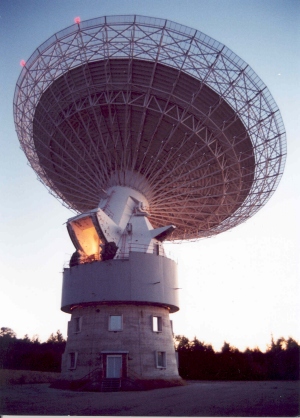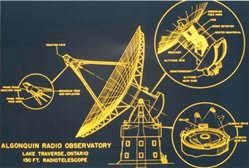The 46 m (150 ft) antenna at Algonquin Radio Observatory is Canada's largest antenna. Commissioned in 1965, the telescope is a fine example of a monster machine. The giant dish is fully steerable and can track with arc second precision the faintest object in the sky. Powerful motors turn the giant antenna in azimuth and elevation to point at any location in the sky. The moving part of the antenna rests 1000 tonnes on the pedestal base.
 The antenna was designed by consulting engineers Freeman Fox company and constructed by the Montreal-based Dominon Bridge Co. on behalf of the National Research Council of Canada. Construction of the instrument required a giant crane that was shipped from the United Kingdom especially for the project. The antenna was surveyed by N. W. Broten using theodolite and metal tape held under tension into order to achieve a surface precision of about one millimeter. Giant steal plates, each formed into a section of a parabola, created the surface. The plates were adjusted and tuned manually in order to optimize the performance of the dish. A later survey by T. H. Legg et. al using single-receiver holography in 2003 indicates that the dish surface still meets it's original performance requirements today.
The antenna was designed by consulting engineers Freeman Fox company and constructed by the Montreal-based Dominon Bridge Co. on behalf of the National Research Council of Canada. Construction of the instrument required a giant crane that was shipped from the United Kingdom especially for the project. The antenna was surveyed by N. W. Broten using theodolite and metal tape held under tension into order to achieve a surface precision of about one millimeter. Giant steal plates, each formed into a section of a parabola, created the surface. The plates were adjusted and tuned manually in order to optimize the performance of the dish. A later survey by T. H. Legg et. al using single-receiver holography in 2003 indicates that the dish surface still meets it's original performance requirements today.
 Freeman Fox also designed Algonquin's sister dish at the Parkes Observatory in Australia. Mechanically identical to ARO, the Austrialia telescope has a slightly larger surface as it was not required to observe wavelengths shorter than 21cm, increasing construction tolerances. The telescope at Parkes was responsible for returning video of the first lunar landing during Apollo 11.
Freeman Fox also designed Algonquin's sister dish at the Parkes Observatory in Australia. Mechanically identical to ARO, the Austrialia telescope has a slightly larger surface as it was not required to observe wavelengths shorter than 21cm, increasing construction tolerances. The telescope at Parkes was responsible for returning video of the first lunar landing during Apollo 11.